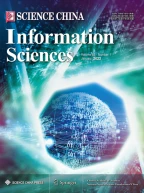Abstract
We study the problem of quantum multi-unicast communication over the butterfly network in a quantum-walk architecture, where multiple arbitrary single-qubit states are transmitted simultaneously between multiple source-sink pairs. Here, by introducing quantum walks, we demonstrate a quantum multi-unicast communication scheme over the butterfly network and the inverted crown network, respectively, where the arbitrary single-qubit states can be efficiently transferred with both the probability and the state fidelity one. The presented result concerns only the butterfly network and the inverted crown network, but our techniques can be applied to a more general graph. It paves a way to combine quantum computation and quantum network communication.
Similar content being viewed by others
Explore related subjects
Discover the latest articles, news and stories from top researchers in related subjects.References
Zhou Z L, Wu Q J, Huang F, et al. Fast and accurate near-duplicate image elimination for visual sensor networks. Int J Distrib Sens N, doi: 10.1177/1550147717694172
Zhang Y H, Sun X M, Wang B W. Efficient algorithm for K-Barrier coverage based on integer linear programming. China Commun, 2016, 13: 16–23
Pan Z Q, Lei J J, Zhang Y, et al. Fast motion estimation based on content property for low-complexity H. HEVC encoder. IEEE Trans Broadcast, 2016, 62: 675–684
Pan Z Q, Jin P, Lei J J, et al. Fast reference frame selection based on content similarity for low complexity HEVC encoder. J Vis Commun Image R, 2016, 40: 516–524
Zhang J, Tang J, Wang T B, et al. Energy-efficient data-gathering rendezvous algorithms with mobile sinks for wireless sensor networks. Int J Sens Netw, 2017, 23: 248–257
Ahlswede R, Cai N, Li S-Y R, et al. Network information flow. IEEE Trans Inf Theory, 2000, 46: 1204–1216
Wootters W K, Zurek W H. A single quantum cannot be cloned. Nature, 1982, 299: 802–803
Hayashi M, Iwama K, Nishimura H, et al. Quantum network coding. In: Proceedings of Annual Symposium on Theoretical Aspects of Computer Science. Berlin: Springer, 2007. 4393: 610–621
Hayashi M. Prior entanglement between senders enables perfect quantum network coding with modification. Phys Rev A, 2007, 76: 040301
Satoh T, Le Gall F, Imai H. Quantum network coding for quantum repeaters. Phys Rev A, 2012, 86: 032331
Soeda A, Kinjo Y, Turner P S, et al. Quantum computation over the butterfly network. Phys Rev A, 2011, 84: 012333
Li J, Chen X B, Xu G, et al. Perfect quantum network coding independent of classical network solutions. IEEE Commun Lett, 2015, 19: 115–118
Li J, Chen X B, Sun X M, et al. Quantum network coding for multi-unicast problem based on 2D and 3D cluster states. Sci China Inf Sci, 2016, 59: 042301
Mahdian M, Bayramzadeh R. Perfect K-pair quantum network coding using superconducting qubits. J Supercond Nov Magn, 2015, 28: 345–348
Shang T, Li J, Pei Z, et al. Quantum network coding for general repeater networks. Quantum Inf Process, 2015, 14: 3533–3552
Xu G, Chen X-B, Li J, et al. Network coding for quantum cooperative multicast. Quantum Inf Process, 2015, 14: 4297–4322
Shang T, Du G, Liu J-W. Opportunistic quantum network coding based on quantum teleportation. Quantum Inf Process, 2016, 15: 1743–1763
Kobayashi H, Le Gall F, Nishimura H, et al. Perfect quantum network communication protocol based on classical network coding. In: Proceedings of IEEE International Symposium on Information Theory (ISIT), Austin, 2010. 2686–2690
Kobayashi H, Le Gall F, Nishimura H, et al. Constructing quantum network coding schemes from classical nonlinear protocols. In: Proceedings of IEEE International Symposium on Information Theory (ISIT), St. Petersburg, 2011. 109–113
Jain A, Franceschetti M, Meyer D A. On quantum network coding. J Math Phys, 2011, 52: 032201
Wang X-L, Chen L-K, Li W, et al. Experimental ten-photon entanglement. Phys Rev Lett, 2016, 117: 210502
Leung D, Oppenheim J, Winter A. Quantum network communication: the butterfly and beyond. IEEE Trans Inf Theory, 2010, 56: 3478–3490
Aharonov D, Ambainis A, Kempe J, et al. Quantum walks on graphs. In: Proceedings of the 33rd ACM Symposium on Theory of Computing, Hersonissos, 2001. 50–59
Ambainis A. Quantum walk algorithm for element distinctness. SIAM J Comput, 2007, 37: 210–239
Magniez F, Santha M, Szegedy M. Quantum algorithms for the triangle problem. SIAM J Comput, 2007, 37: 413–424
Tamascelli D, Zanetti L. A quantum-walk-inspired adiabatic algorithm for solving graph isomorphism problems. J Phys A-Math Theor, 2014, 47: 325302
Childs A M, Ge Y M. Spatial search by continuous-time quantum walks on crystal lattices. Phys Rev A, 2014, 89: 052337
Babatunde A M, Cresser J, Twamley J. Using a biased quantum random walk as a quantum lumped element router. Phys Rev A, 2014, 90: 012339
Zhan X, Qin H, Bian Z-H, et al. Perfect state transfer and efficient quantum routing: a discrete-time quantum-walk approach. Phys Rev A, 2014, 90: 012331
Yalçınkaya İ, Gedik Z. Qubit state transfer via discrete-time quantum walks. J Phys A-Math Theor, 2015, 48: 225302
Travaglione B C, Milburn G J. Implementing the quantum random walk. Phys Rev A, 2002, 65: 032310
Tregenna B, Flanagan W, Maile R, et al. Controlling discrete quantum walks: coins and initial states. New J Phys, 2003, 5: 83
Soeda A, Kinjo Y, Turner P S, et al. Quantum computation over the butterfly network. 2011. arXiv: 1010.4350v3
Rohde P P, Schreiber A, Stefanak M, et al. Increasing the dimensionality of quantum walks using multiple walkers. J Comput Theor Nano, 2013, 10: 1644–1652
Raussendorf R, Browne D E, Briegel H J. Measurement-based quantum computation on cluster states. Phys Rev A, 2003, 68: 022312
Acknowledgements
This work was supported by National Natural Science Foundation of China (Grant Nos. 61572053, 61671087, U1636106, 61602019, 61472048, 61402148), Beijing Natural Science Foundation (Grant No. 4162005), and Natural Science Foundation of Hebei Province (Grant No. F2015205114).
Author information
Authors and Affiliations
Corresponding author
Rights and permissions
About this article
Cite this article
Yang, Y., Yang, J., Zhou, Y. et al. Quantum network communication: a discrete-time quantum-walk approach. Sci. China Inf. Sci. 61, 042501 (2018). https://doi.org/10.1007/s11432-017-9190-0
Received:
Revised:
Accepted:
Published:
DOI: https://doi.org/10.1007/s11432-017-9190-0
